Francesca and Henk-Jan's Backpacking Trip!
Thursday, August 19, 2010
On The Road Again!
The morning of the 18th, before the veil of darkness had been lifted from Lhasa, Francesca and I headed downstairs for another tasty breakfast. Sadly, darkness also still covered the restaurant… Luckily the staff woke up after a while and prepared our food. Francesca and Sam got their food to go, giving us a few Tibetan breads for the road. We all said a quick ‘hello’ to Ray and his co-pilot Monday, our new driver. Our bags were packed and ready, so he transferred them to our equally new car for us. We had a long day of driving ahead of us, Ray explained, so we’d better get going.
Our first stop of the day would be the third of the three great Gelugpa Monasteries: Ganden Monastery. The 45 kilometer drive from Lhasa took us east of the city, and up into the mountains. A scenic drive it was also, as proven by some of the following pictures. Ganden Monastery lies at the top of Wangbur Mountain at an impressive altitude of 4500 meters – that’s 900 meters higher than Lhasa! Seeing it appear in the distance, majestically situated on the saddle of the green hills ahead of us, was quite simply breathtaking.
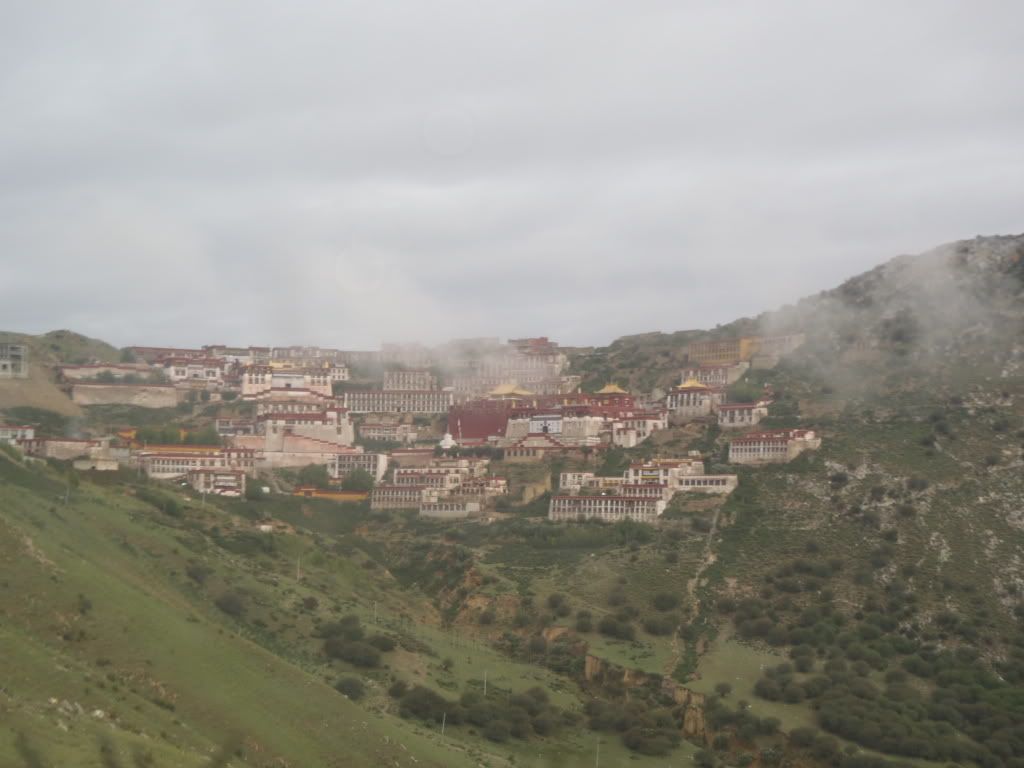
Here are some facts and figures about the Monastery’s history from Wiki:
“[The full name of the Monastery is) is Ganden Namgyal Ling. Ganden means "joyful" and is the Tibetan name for Tusita, the heaven where the bodhisattva Maitreya is said to reside. Namgyal Ling means "victorious temple." It was the original monastery of the Geluk order, founded by Tsongkhapa himself in 1409, and traditionally considered to be the seat of Geluk administrative and political power. The Ganden Tripa or 'throne-holder of Ganden' is the head of the Gelukpa School. Being the farthest from Lhasa of the three university monasteries, Ganden traditionally had a smaller population with some 6,000 monks in the early 20th century.” Nowadays a mere 300 monks find their home in Ganden.

Cold as it was that high up, Francesca put on Sam’s sweater – that she definitely needed – and all of us headed for the Monastery proper. Ray purchased himself some juniper and chucked it in the enormous incense burner in front of one of the halls. We learned that burning juniper and incense – sometimes with some tsampa added in – is believed to produce purifying smoke. It is used in both monasteries and homes to make people's body and soul purified. Besides the nice smell the burning juniper produced the heat emitted by the burner was quite nice as well.
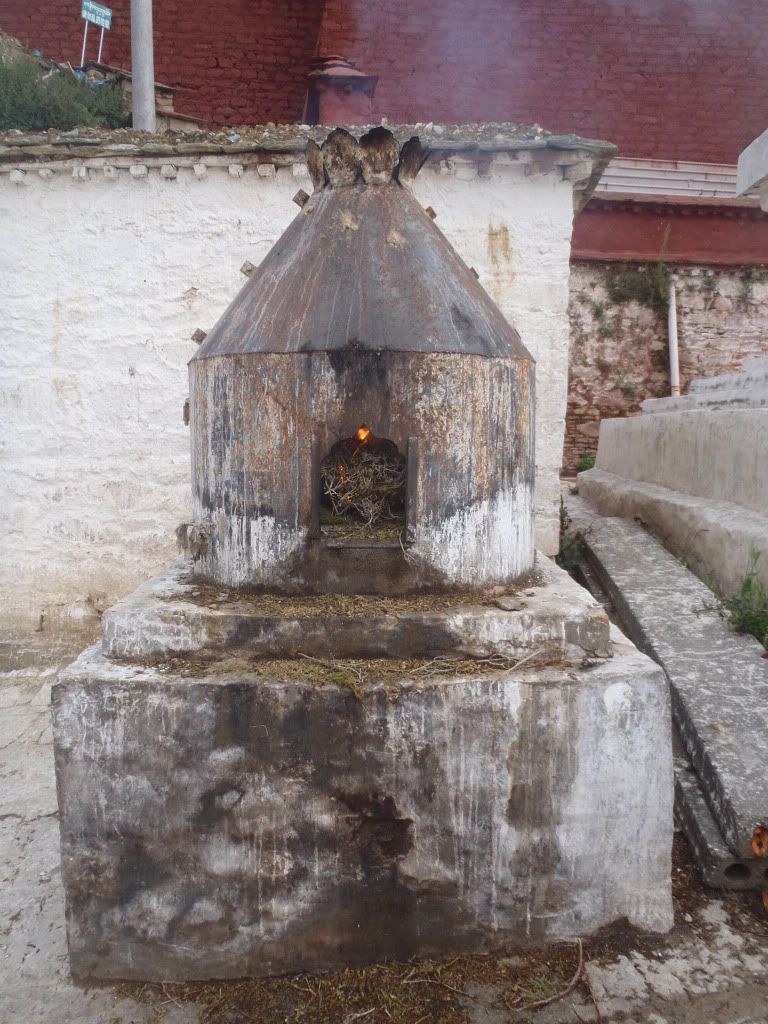
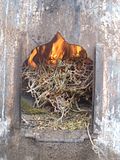
Onwards and upwards! We headed up the stairs to check out the first of the three main sights in the Ganden Monastery. The Ngam Cho Khang Chapel, the place where Tsongkhapa himself traditionally taught his lessons, was our first stop. Books filled with Buddha’s texts lined the wall of the enormous hall. We learned from Ray that you’re supposed to walk under the books to acquire a little knowledge and gain some merit. Naturally we followed suit and emerged a tad bit more enlightened. It was no surprise to hear that the hall was still in use, even though the resident monks cannot fill all the seats inside even if they were to bring their entire families. Statues can be found at the back-end of the hall, where Tsongkhapa is accompanied by two of his disciples. The future Buddha Maitreya also makes his mandatory appearance.
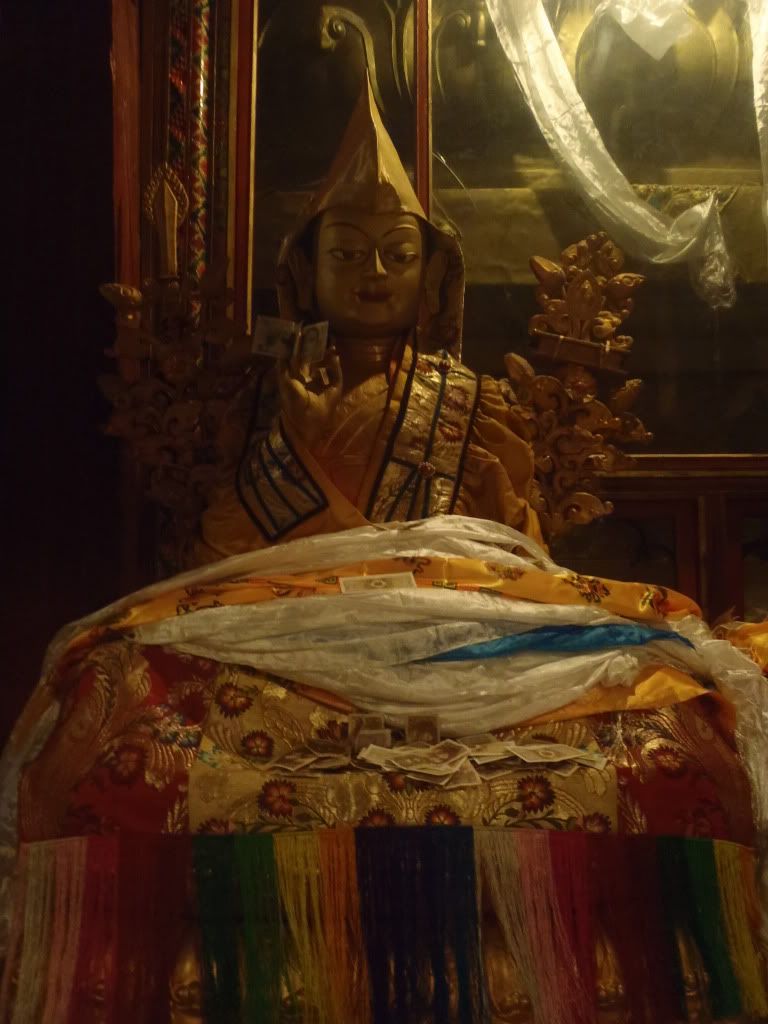


A short walk past some more colorfully painted buildings and walls led us to the Tsokchen Assembly Hall, where we discovered the triple longevity Buddhas, as well as another sand mandala. I still can’t get over the beauty of those things! A little more interesting were the ritual cakes made out of yak butter and tsampa. These guys can literally make anything with yaks and barley… We paid to take some pictures in a special hall with a Shakyamuni Buddha, encased in glass with a beautifully carved wooden frame. On either side of the statue were more glass encasings with rows and rows of smaller Shakyamunis. The small stupa (also behind glass) is sad to have been left untouched since Buddha’s life. I’m not entirely sure about that, what with all the destruction and reconstruction going on in the past…
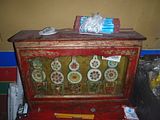
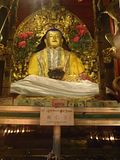
Next to that hall Ray pointed out the bull-headed protector’s chapel. Apparently, only men are allowed to view Yamataka’s statue here. I left the girls in Ray’s care and had a quick look in the small chapel, where several monks were chanting away. Not terribly impressed by it I headed back out to join our little sortie as we made our way to our third hall.
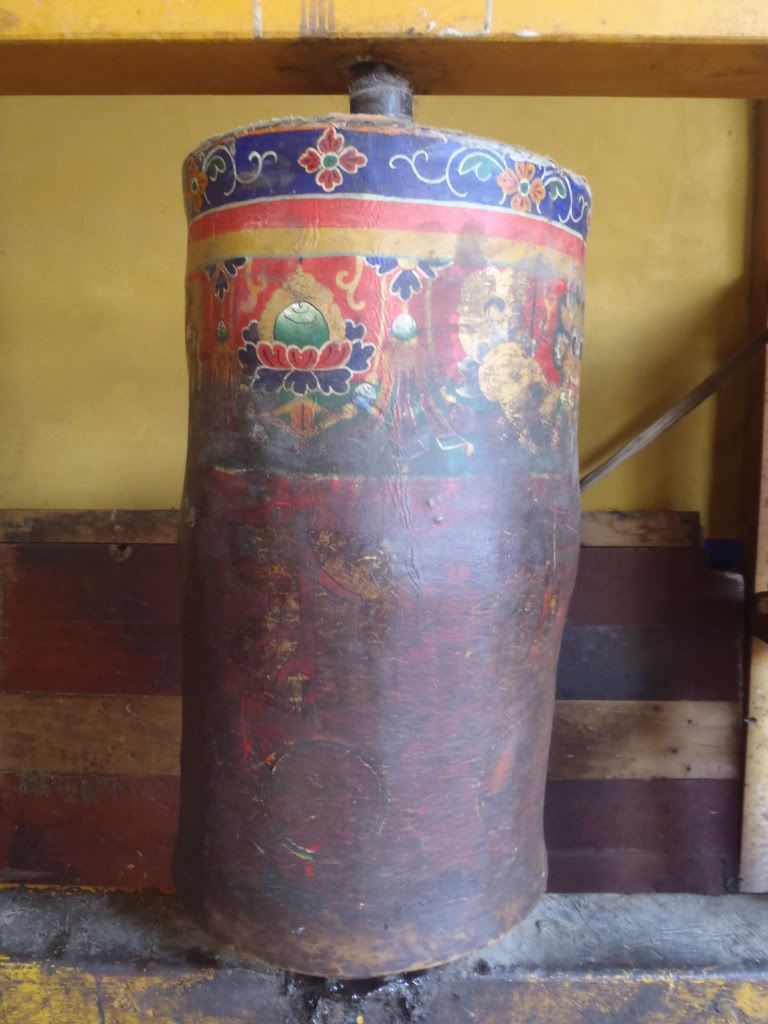
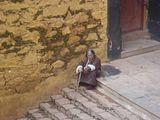
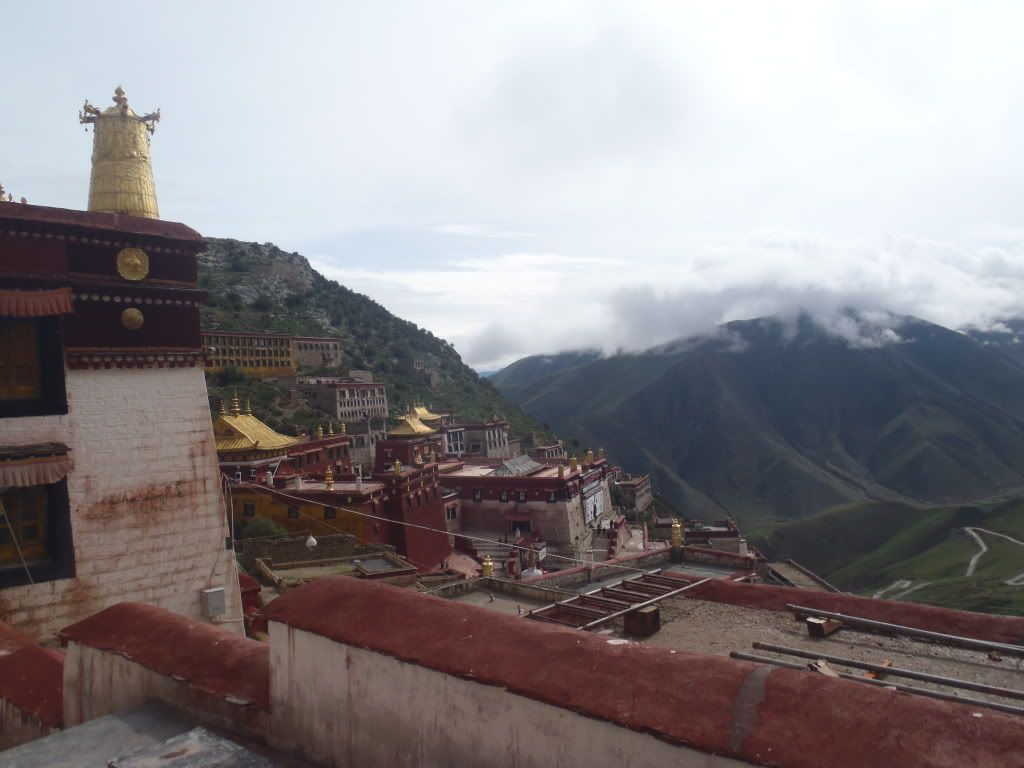
The definite highlight however came in the shape of the Serdung, or Holy Stupa Hall. The Serdung was used by Tsongkhapa and other Tripas. In 1419, Tsongkhapa passed away and in the following year his disciples established the hall for him, as well as a silver pagoda inside with more than 35 kilograms of silver to surround the master's body. Afterwards, the thirteenth Dalai Lama covered it with pure gold. From then on, each time a Tripa died, a silver pagoda would be built in their honor. In the time leading up to the Chinese invasion of Tibet, 95 pagodas were built.
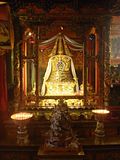
Sadly, the tomb was partially destroyed during the Cultural Revolution and I can only imagine that the rebuilt tomb of Tsongkhapa looks a little less impressive than its predecessor. Ray led us back to the car and told us we’d have lunch back in Lhasa. We were a little surprised to learn we’d be going back to Lhasa so soon, but it made sense with the direction we’d be going in and at least Lhasa would have a variety of food on offer.
Driving back through the gorgeous Lhasa River Valley was no punishment, and Lhasa and its Chinese construction came back in view all too quick. Before finding ourselves a place to eat Francesca and Sam tried to find the ‘great bakery’ she’d been told to go to. I had tried looking for it the night before, but hadn’t been able to locate it. Luckily Sam had a drawn map, which helped us find the courtyard of a hotel, where the “Summit Café” had been hidden. The snacks on display quickly got the girls’ attention! Francesca and I got a chocolate cake, a brownie and chocolate chip cookie for the road, as well as a whole stack of Coke Zero-cans, because they were extremely hard to get elsewhere.
Lunch followed and was to be ordered in the Tashi One, a place we hadn’t visited before. Boy, were we surprised to find the entire place empty! We took a table and perused the menu. It didn’t take long to make up our minds, as the house specialty was a chicken and vegetable wrap with a cream cheese sauce. We ordered a few portions of the wraps, along with some fried yak momos. The food came quickly and tasted pretty good. We have to admit that the wraps looked and tasted a little ‘Mexican.’ Perhaps there’s a future in Tibet-Mex after all! The fried yak momos were sadly not as good as their boiled counterparts – we made a mental note to stick to the latter from then on.
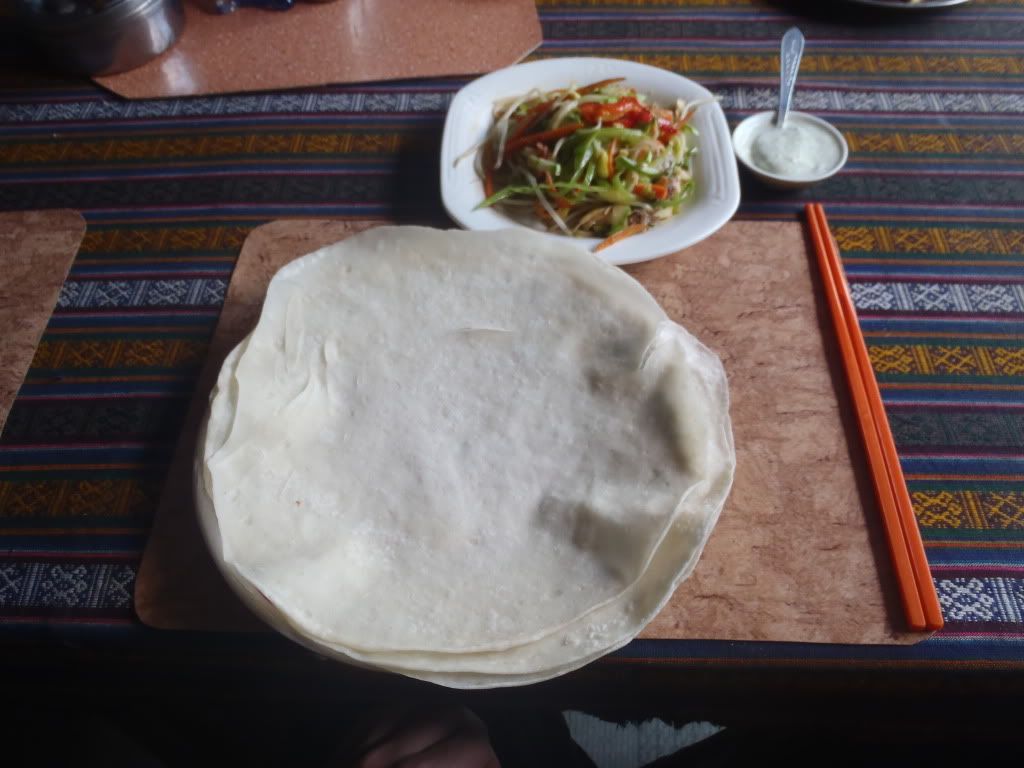

Inevitably lunch ended and driving continued. Saying goodbye to Lhasa for the second time that day, we drove out of the city in a … direction. On our way out we spotted a giant statue of two yaks by the side of the road. Pretty neat! After a good 2 hours of driving Monday and Ray thought it would be time for a break. We made a stop by the side of the road and climbed up to a small temple, where we had a great view of the river and mountains around us. We took some pictures and noticed how the landscape here looked distinctly different from our previous surroundings. There was far less green and far more sand, giving the area a distinct ‘desert’ look.

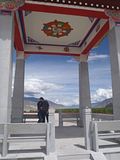

Ray even pointed our destination out, right across the river – just a small dot. A ferry would’ve easily been able to take us across in half an hour, but since it wasn’t in service at the time of writing we had to drive all the way around. The scenic drive was nice, but the little detour ended up costing us a few extra hours, seeing us arrive around 6:00 PM. We looked around for a hotel, quickly settling for a half-decent place near the Monastery. Since we’d bought so much, and had even brought part of that morning’s breakfast with us we decided not to go for dinner. I made us some sandwiches, which, combined with Francesca’s collection of chocolate goodies, made for a pretty decent dinner.
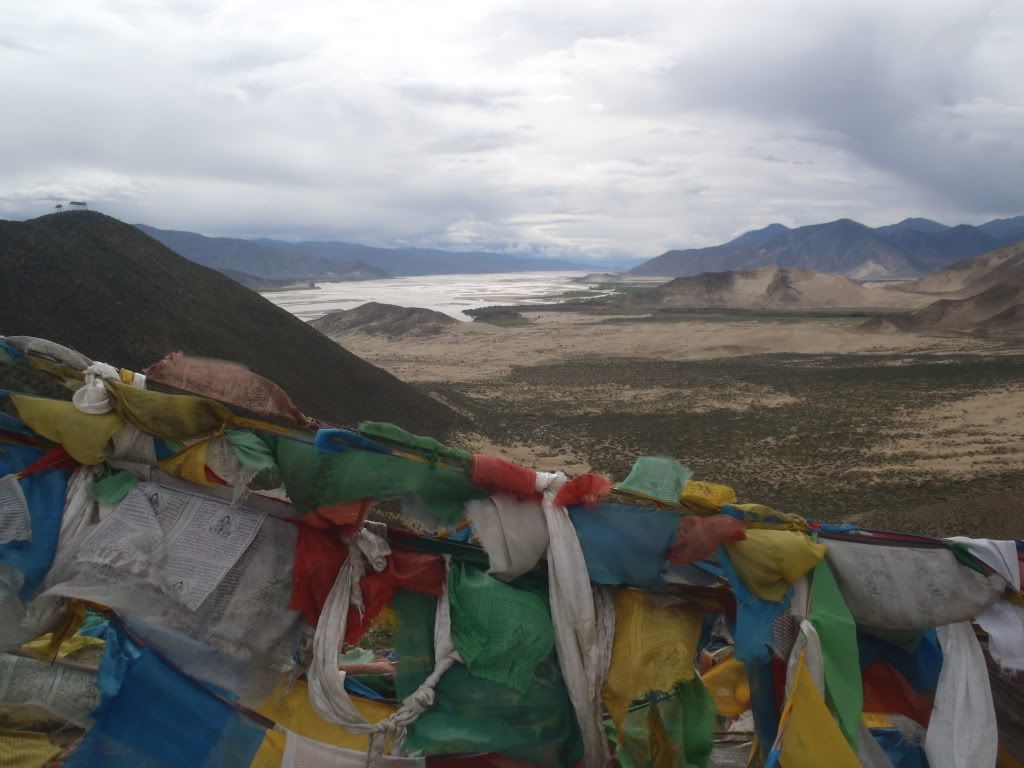
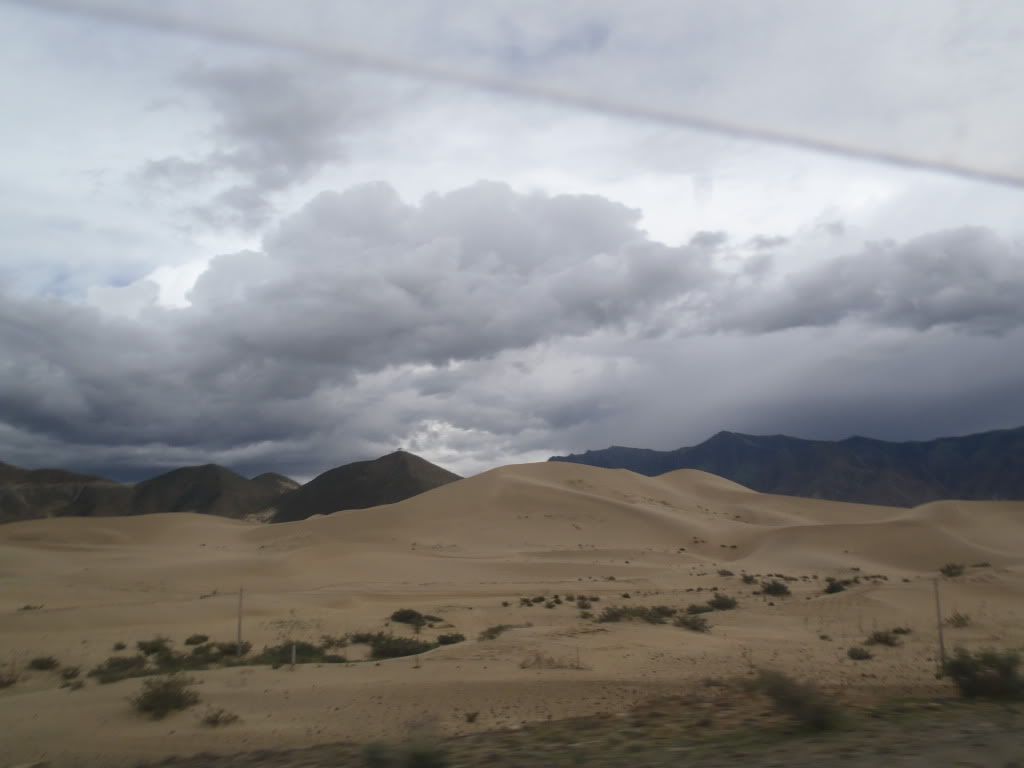
The next morning Francesca and I decided to do the same thing. There was no need to head out for a mediocre breakfast in the crappy town we were in. Instead we met Ray and Sam outside the hotel around 9:30 AM and headed straight for the only worthwhile sight in town: Samye Monastery. Wiki: “The Samye Monastery or Samye Gompa was the first Buddhist monastery built in Tibet, most probably constructed between 775 and 779 AD under the patronage of King Trisong Detsen. The King sought to revitalize Buddhism, which had declined since its introduction by King Songtsen Gampo in the 7th century.”
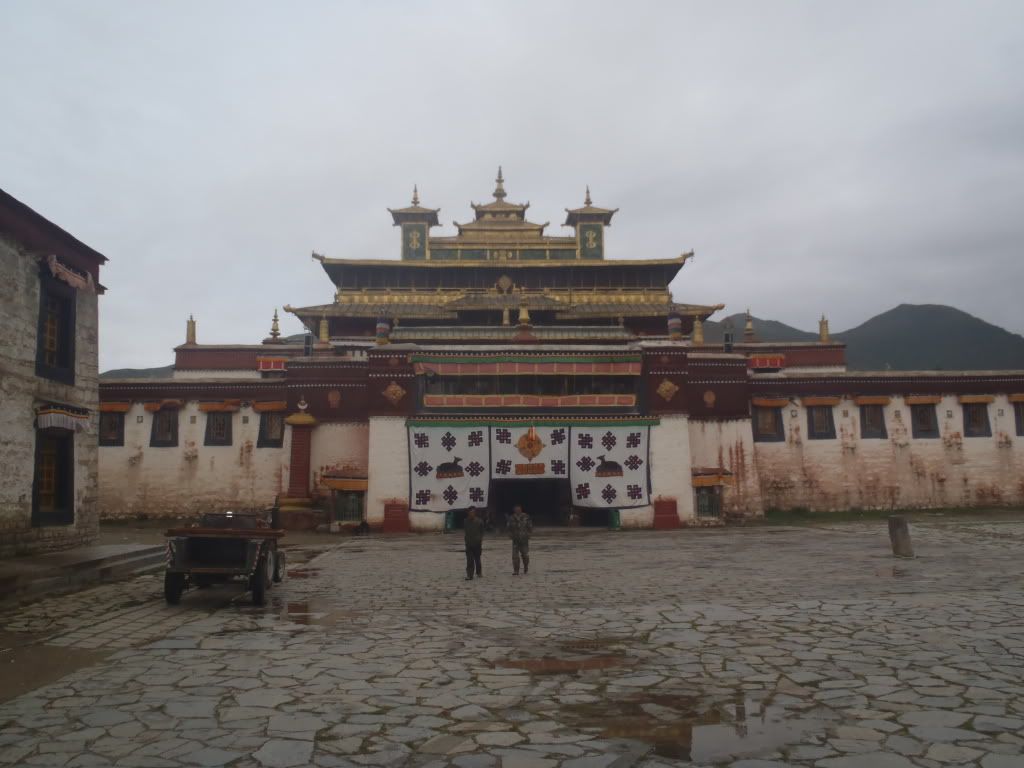
Furthermore, the Indian Buddhist masters Padmasambhava and Shantarakshita, whom the king had invited to Tibet to help spread Buddhism, play an important role in Samye’s history. Padamasambhava is credited with subduing the local spirits and winning them over to Buddhism. Padmasambhava's involvement makes Samye important in the Nyingma School, but it was later taken over by the Sakya and Gelugpa Schools. Today, Tibetans of all traditions come to worship here.
After purchasing our tickets we followed Ray inside and were immediately pleasantly surprised by the residing monks. They were setting up bowls of colorful sand around a flat table with an intricate drawing on it. If you’ve paid attention to previous posts you’ll know what the monks were about to begin: a sand mandala! We watched the monks put down the first ritual grains of colored sand and hoped we’d get to see plenty more. Ray, however, told us they’d continue setting up for a while longer and that we’d be better off exploring the main temple and its six floors first.
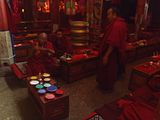
Here’s a little summary of the different sights from sacred-destinations.com: “Flanking the entrance to the main chapel are statues of historical figures associated with Samye's founding: Shantarakshita, Padmasambhava, Trisong Detsen and Songtsen Gampo are among those on the left. To the right of the assembly hall is the Gonkhang, a protector chapel, with eerie statues of former Bon demons that were turned into fierce Buddhist protector deities. The second floor is an open roof area, where monks and locals carry out the craft work for the temple. The third floor contains the Quarters of the Dalai Lama, with a small anteroom, throne room and bedroom. In the bedroom is a barred, glass-fronted case full of wonderful relics: Padmasambhava's hair and walking stick, a Tara statue that is reputed to speak, and the skull of Shantarakshita. The top floors have little to see in themselves, but provide excellent views from their balconies.”
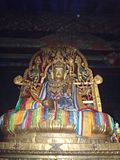
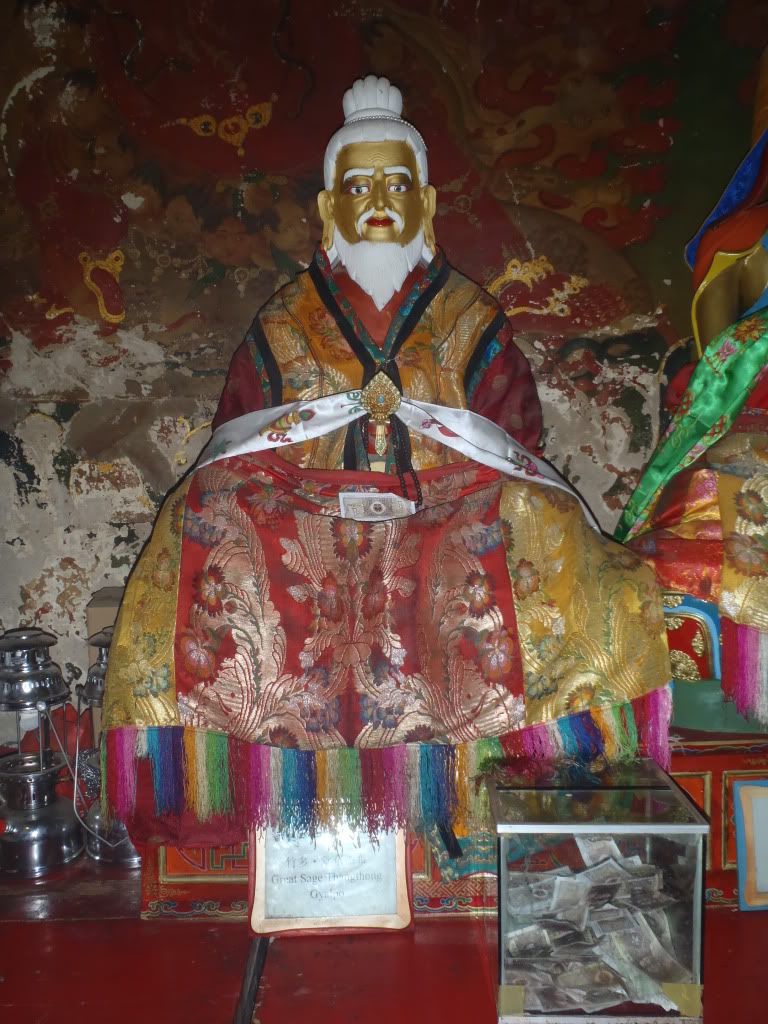
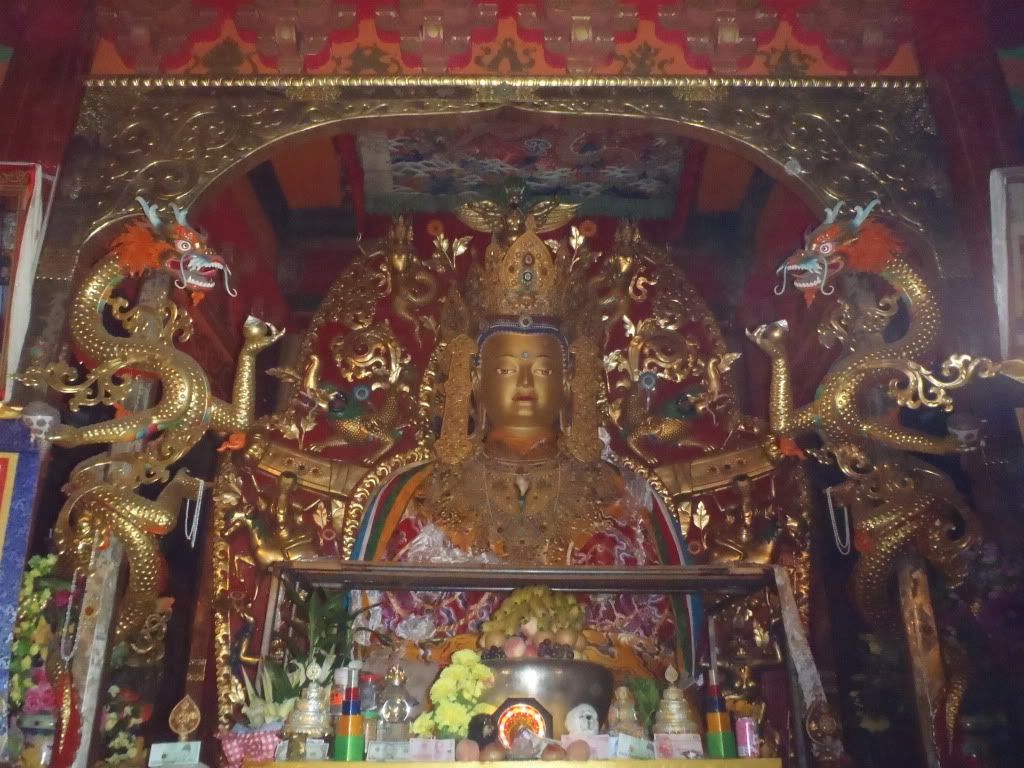
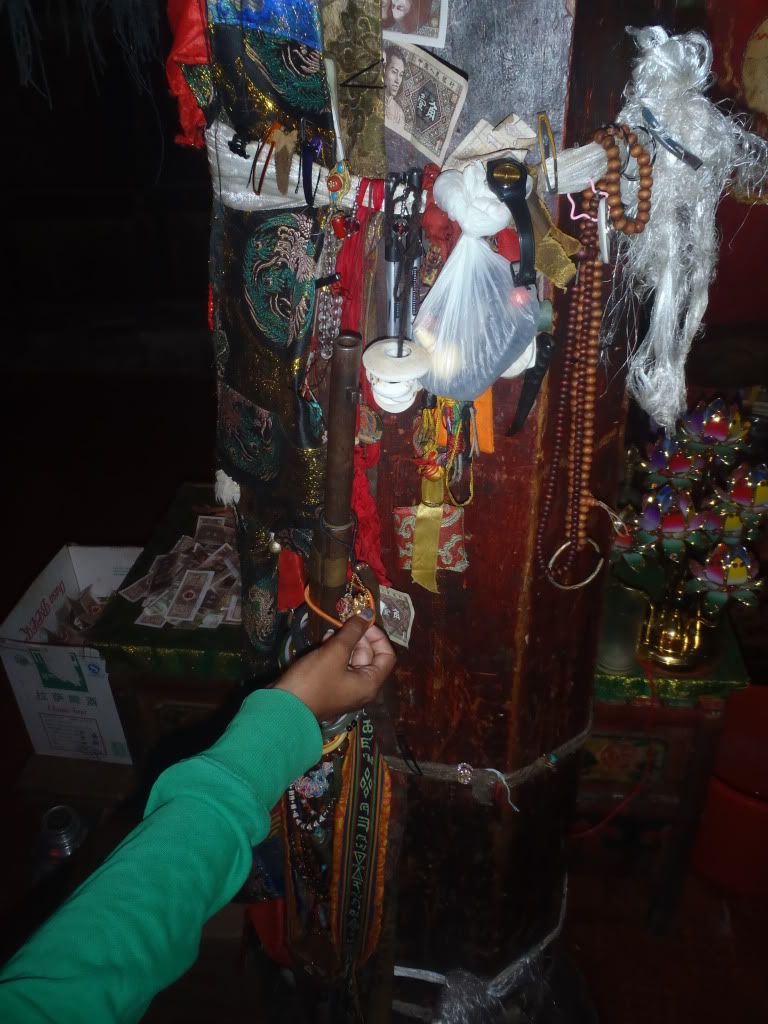
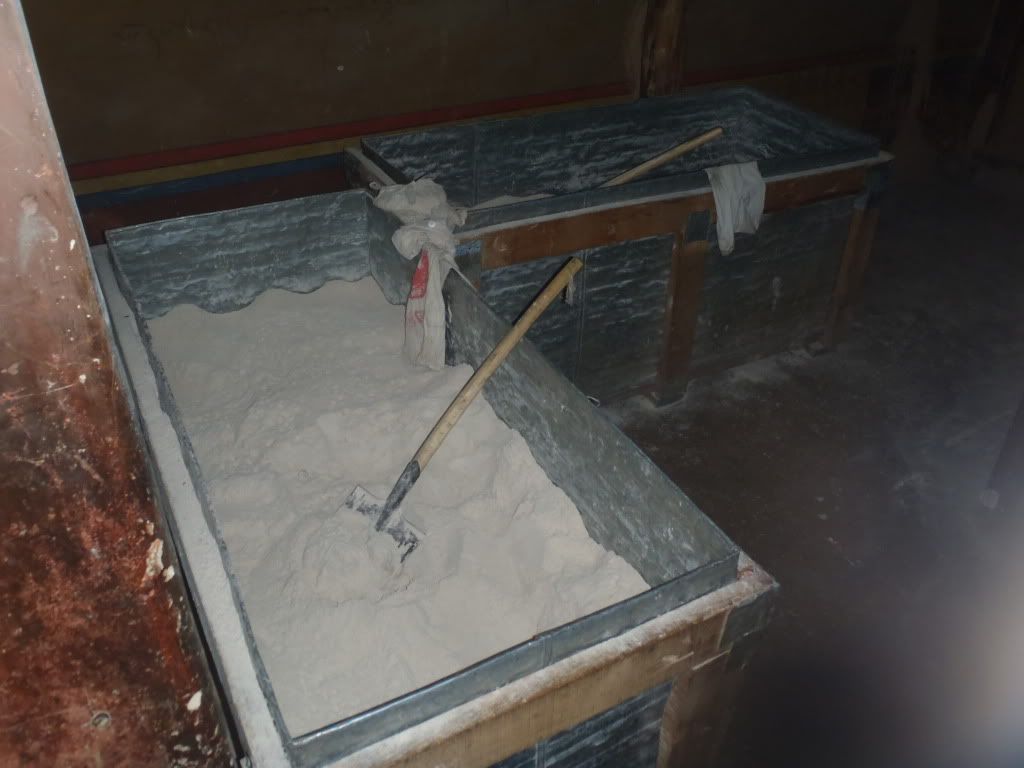
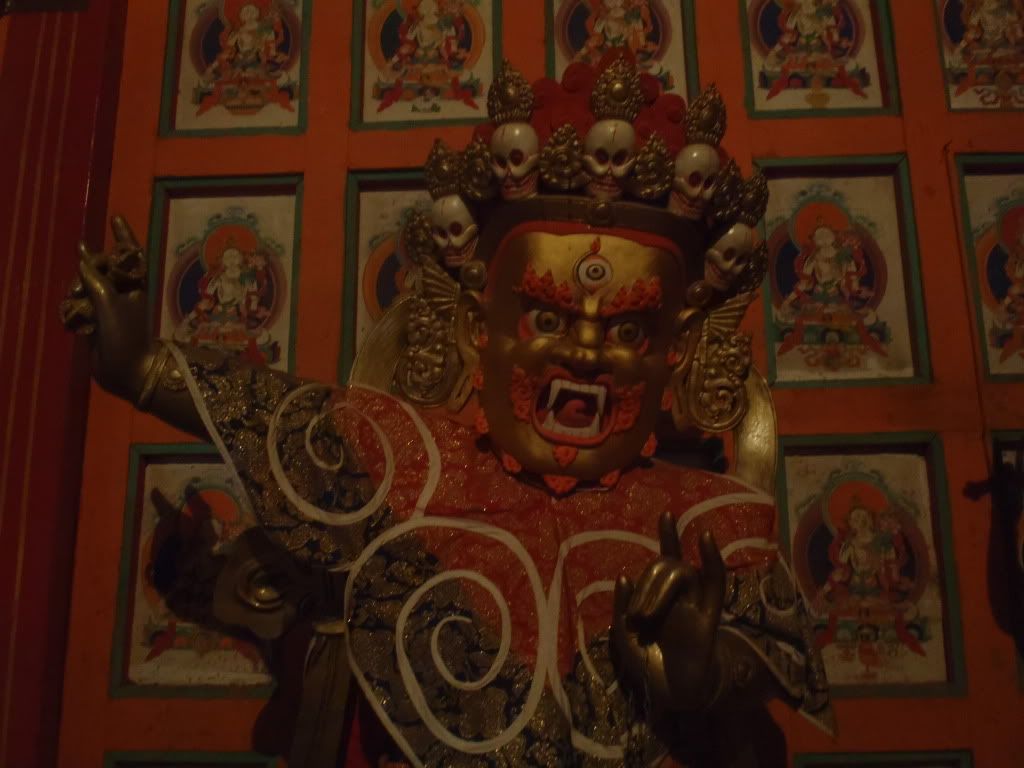
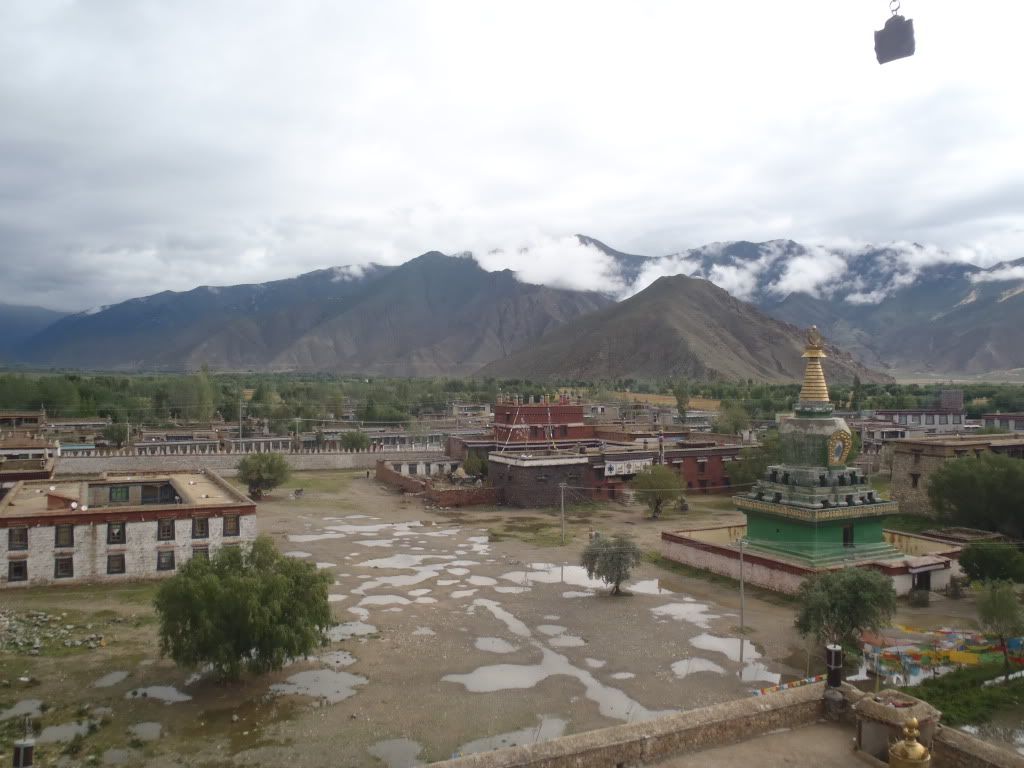
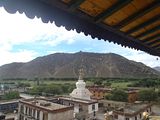
After completing the exploration of the entire building in a speedy 30 minutes we all headed back down to the first floor to watch the monks work on their mandala. We earned a little more about the symbolism behind the image of the mandala in a museum in Nepal – here’s an explanation of how the image can be deconstructed: “The outermost edge of the mandala is a wheel of flames, which represents the basic elements of the world: earth, water, fire and wind. The following ring holds diamond-like lightning bolts (or ‘vajra’), which serve to protect the mandala from external enemies."
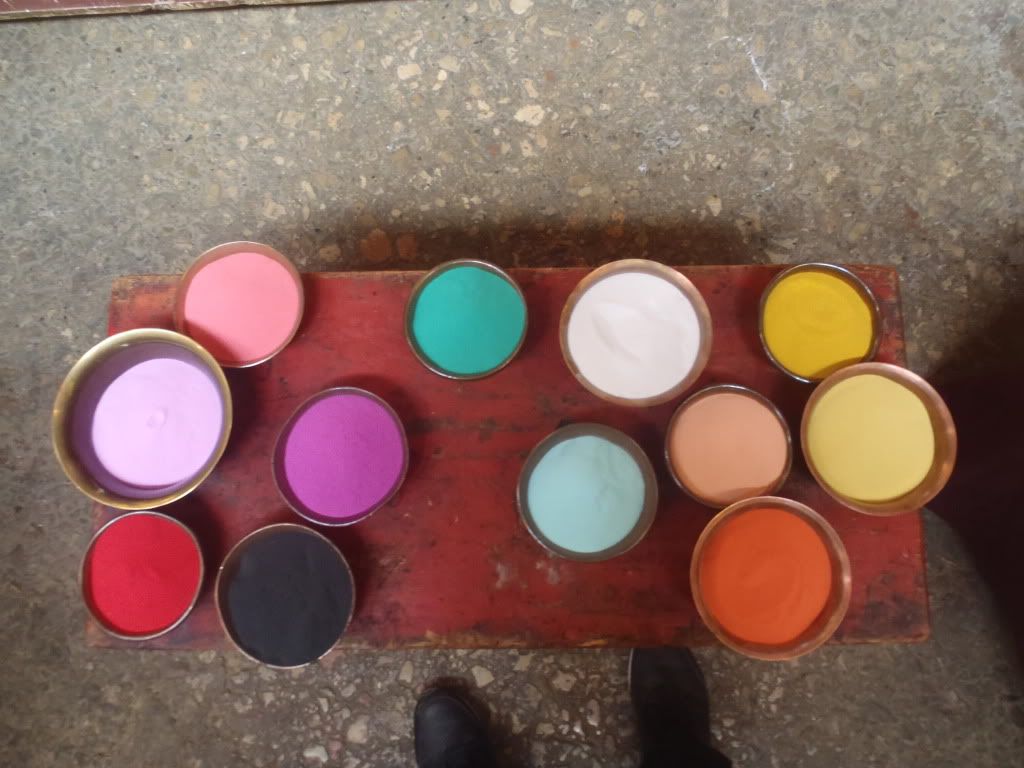
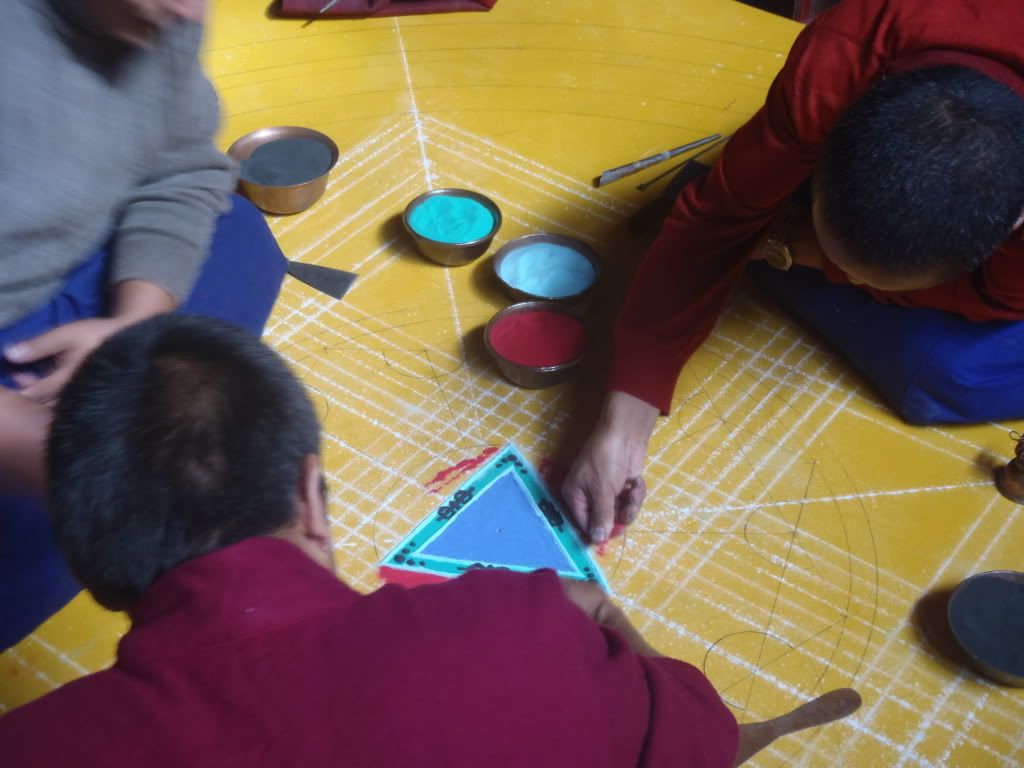
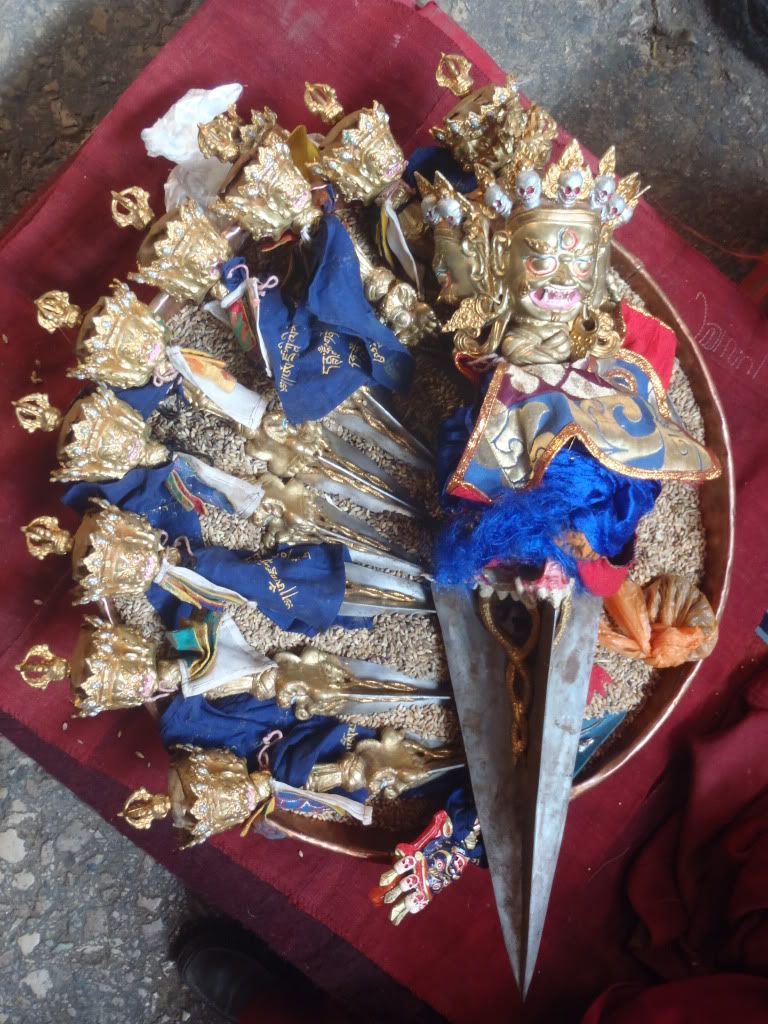
"The inner circle is much more interesting, as it is supposed to represent a tower built upon a giant lotus blossoming on the peak of Mt. Kailash. The roof of the tower is transparent, and sometimes several Buddha figures are drawn within, representing the five elements of body and mind: matter, sensation, simple concept, free will and consciousness. Thus, the mandala depicts both the universe and the individual, and in this way serves as a medium for the union of the cosmos and the self.” Impressive, right? And regardless of all the symbolism, these mandalas just look awesome! Watching the monks painstakingly placing grain after grain really left us all staring in amazement.
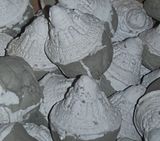
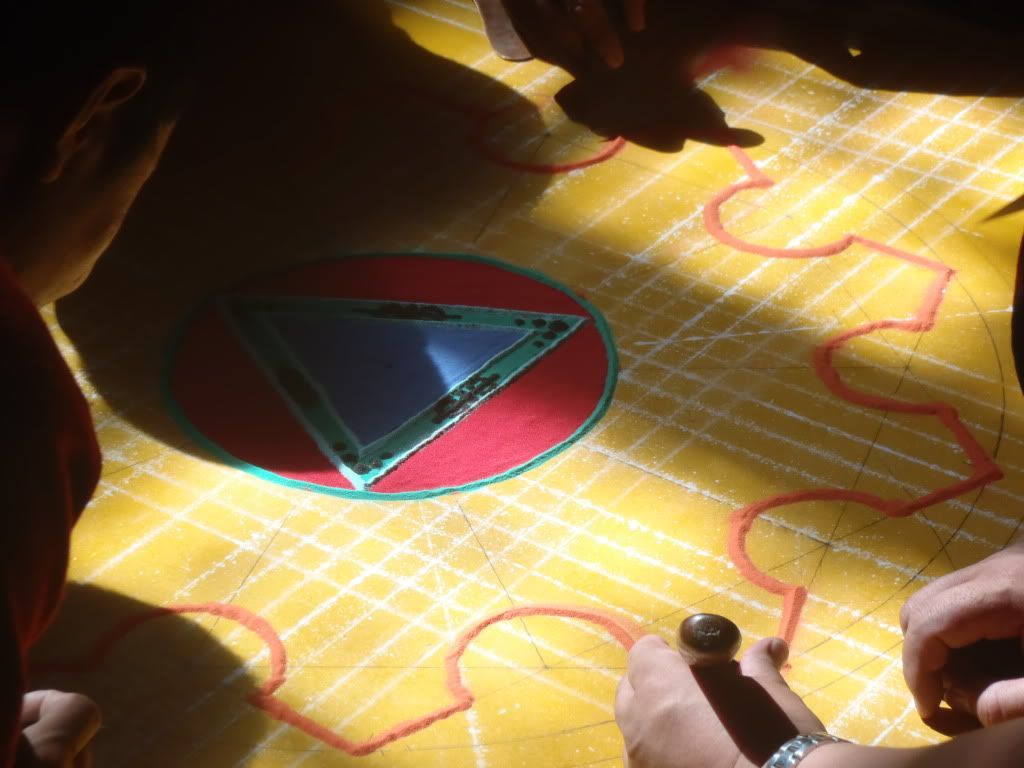
And you know what else is impressive? Samye Monastery itself is laid out on the shape of a giant mandala. The main temple in the center represents Mt. Kailash, the mythical mountain at the center of the Buddhist universe. The four continents in the ocean around Mt. Kailash are represented by four stupas at the cardinal points, each flanked by two smaller temples to symbolize islands in the ocean. We’d seen these four large stupas (or ‘chorten’ in Tibetan) from the 6th floor of the main chapel, and had wondered about their contents. We’d seen that they were all in different colors (red, white, black and green) and Ray told us the current chortens are rebuilt versions of older, destroyed creations and all look slightly different. They’re meant to represent the four king guardians, protecting the temple in the middle.
Ray took us to the black one, which had a few prayer wheels inside, as well as some staircases to higher levels. I was the only one interested in having a look (e.g. the only one that could be bothered to climb a few steps…) and found a few small niches with a few statues inside. Nothing special, safe for the view of the surroundings and Ray and the girls down below.
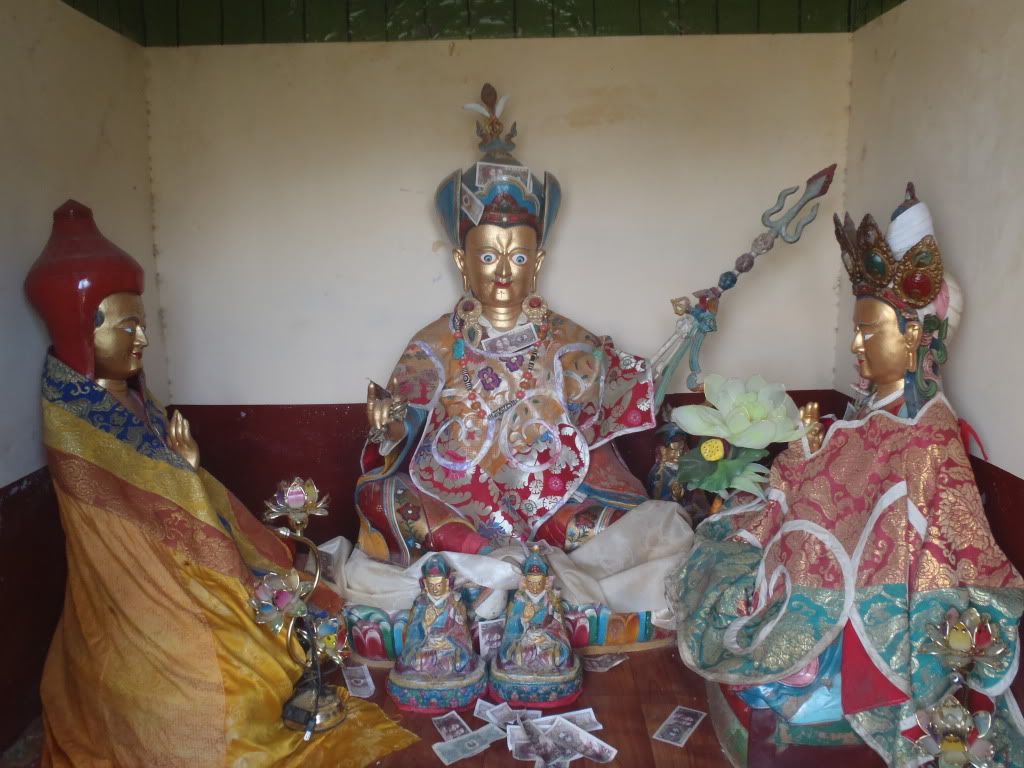
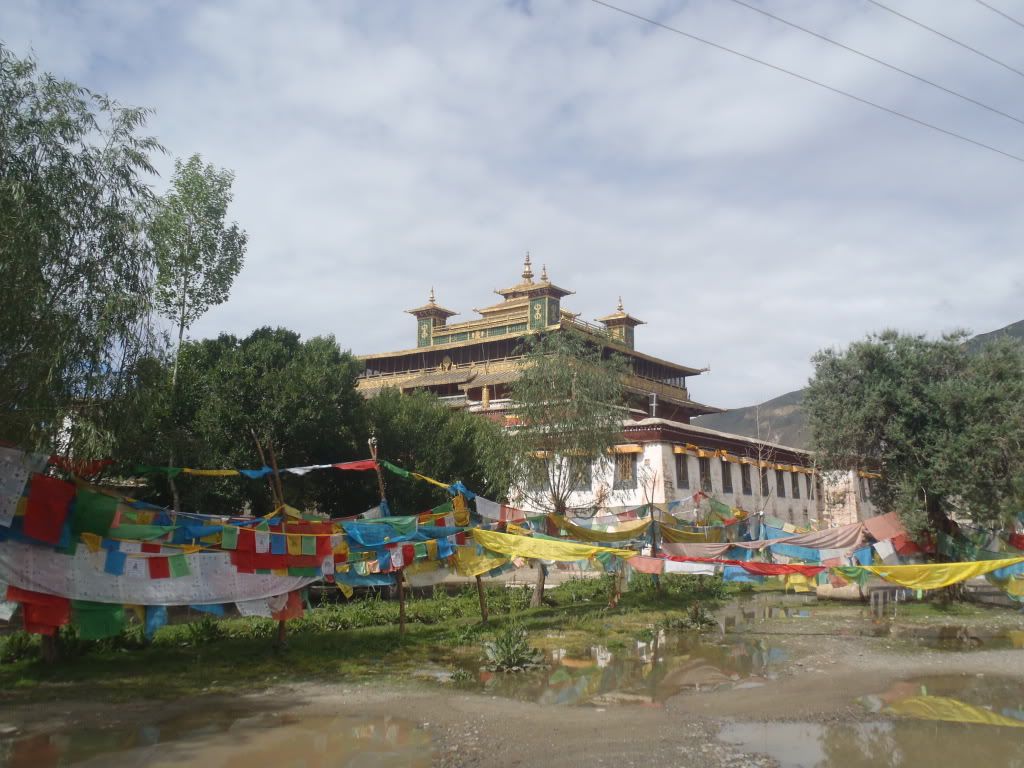
Just before noon we had a quick look at a smaller and older building. Ray showed us a ‘death’-door – a door with a small opening behind which death supposedly resides. Tibetans, since they believe in rebirth, aren’t particularly scared by death, so it was interesting for us to see their approach to something that still frightens a lot of Western people. Apparently, it’s also common practice to leave a note for a departed one on the door as the entire thing was covered in small pieces of paper with a few lines scribbled on.

After our encounter with ‘death’ we all headed back to the car and started driving again. We had another fairly long drive ahead of us to Nagartse and still had more things to see that day. Monday stepped on the pedal and skillfully drove our 4-wheel-drive to the Yungbulakang Palace, not too far from the grey Chinese hole we’d driven through the previous day, Tsedang. We saw the palace from quite a distance, perched on the edge of a mountain range in the distance. Arriving at the parking lot we realized we had quite a climb ahead of us in the hot weather. Francesca and Sam asked Ray for other options, whilst I decided I wouldn’t mind walking. When Ray told us there were horses available I still didn’t care much about 4-legged support. All of that changed the instant Ray pointed at a lone camel, also available for uphill transport!
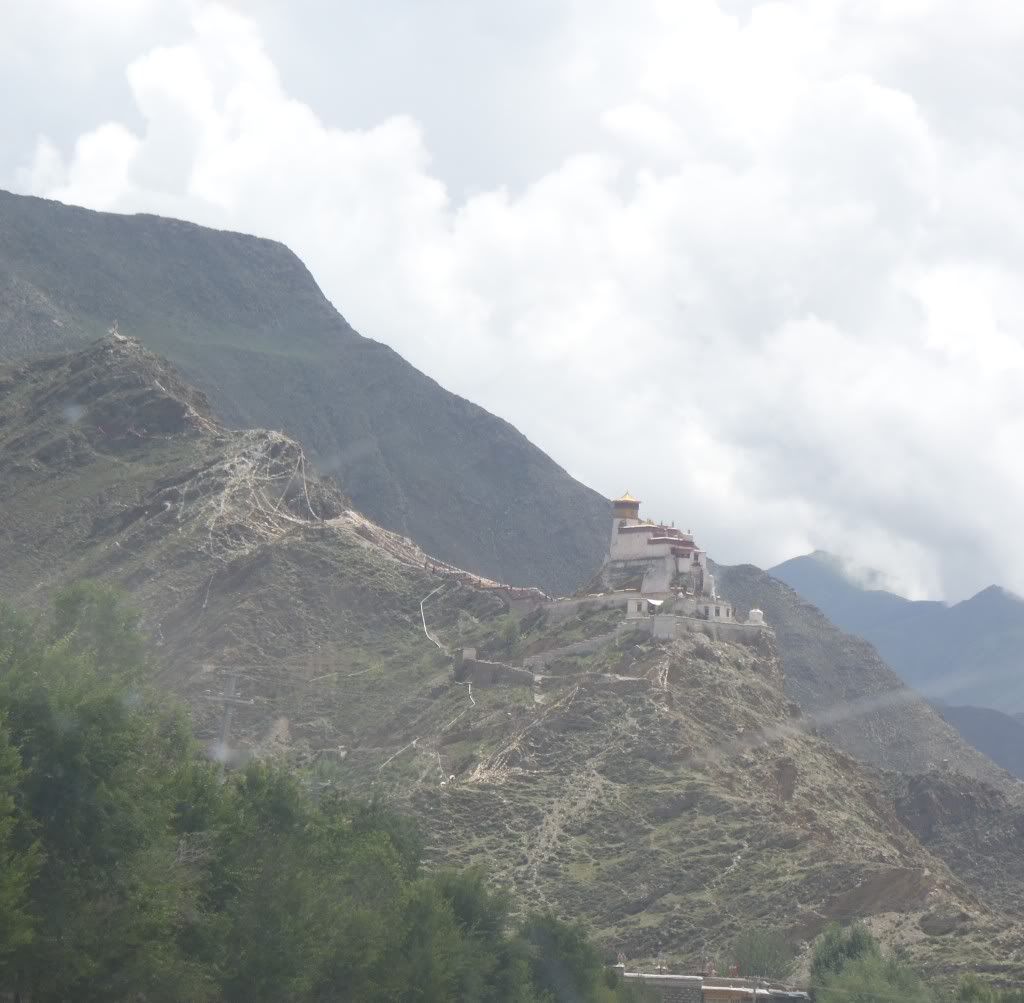
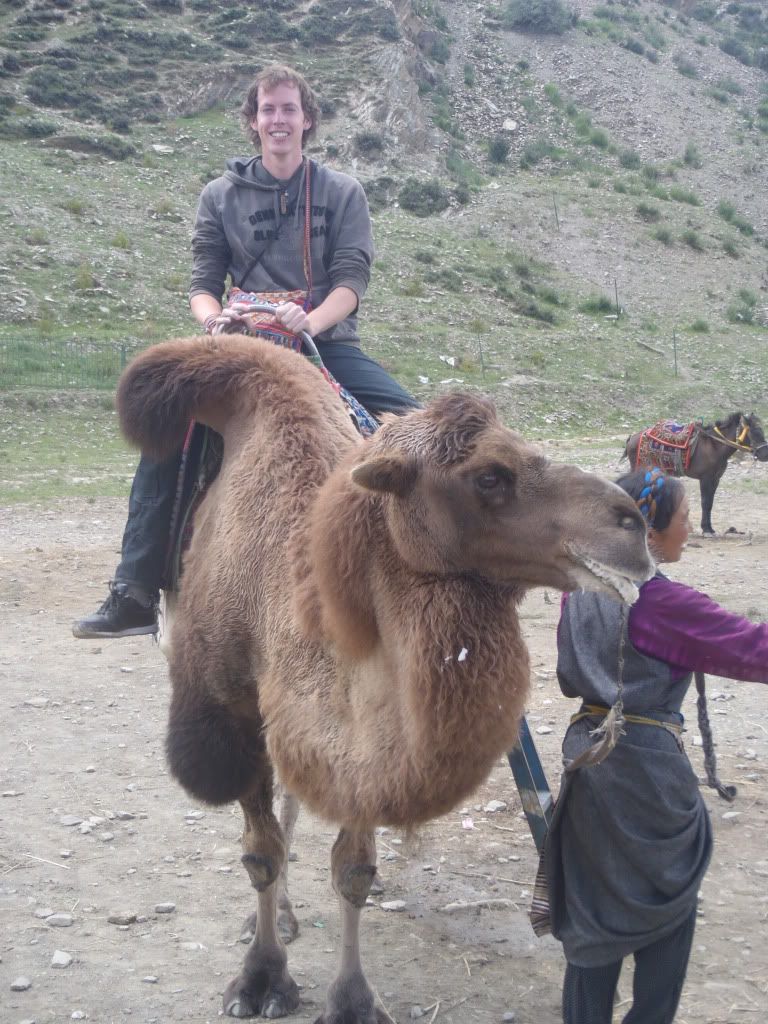
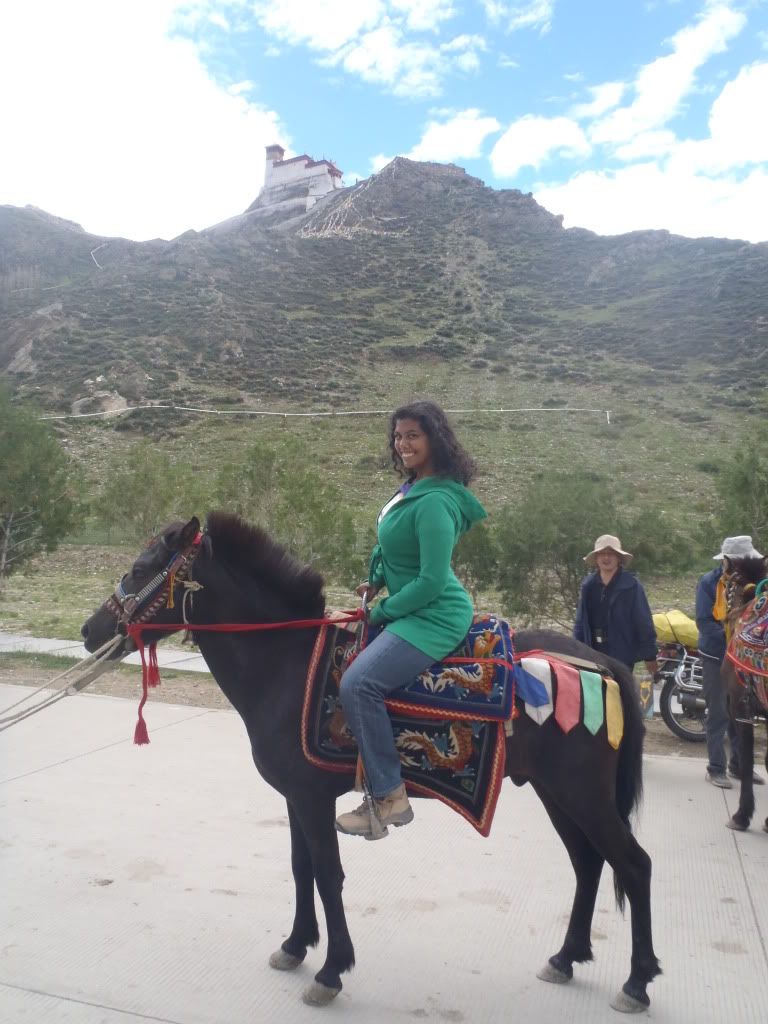
Yes, I got to ride a camel up to the palace! I had no idea those things were so comfortable! We’ve sat on top of quite a few different animals now and I have to say in all honesty that a camel is most definitely the best mode of transport when it comes to the animal kingdom. The only downside is getting on the beast, as it required a ladder (even for me) to get seated. My camel and Francesca’s horse were taken by the hand and we were led uphill. The view of the environs were stunning, and adding a camel to an already picturesque situation can only lead to awesomeness.
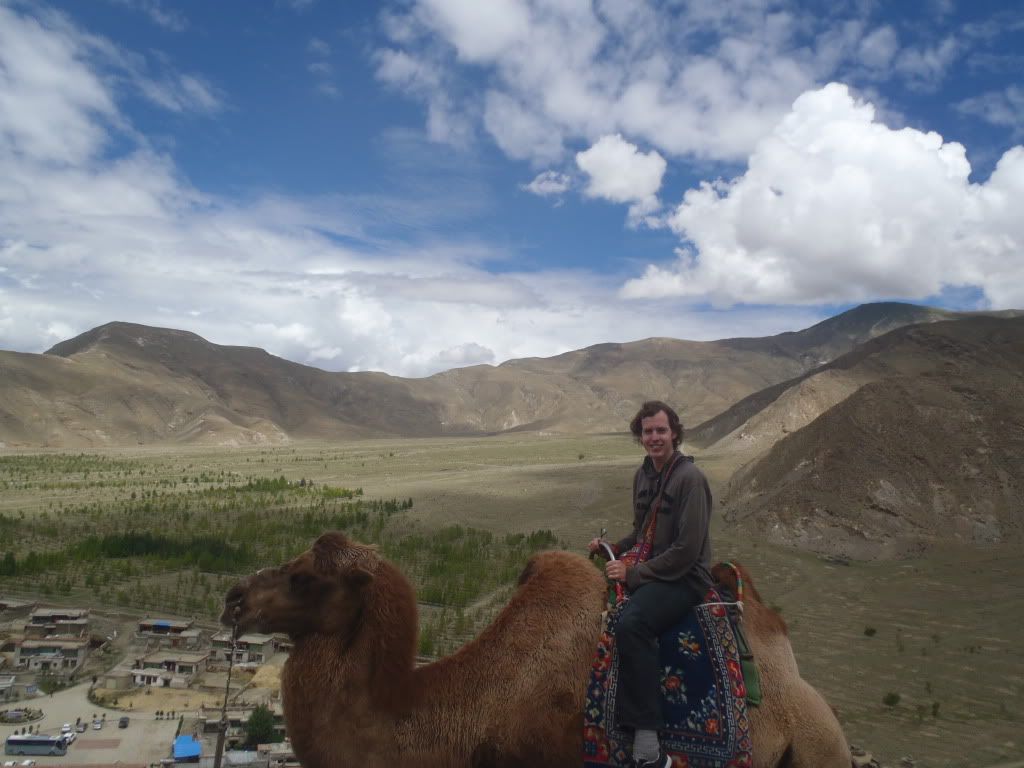
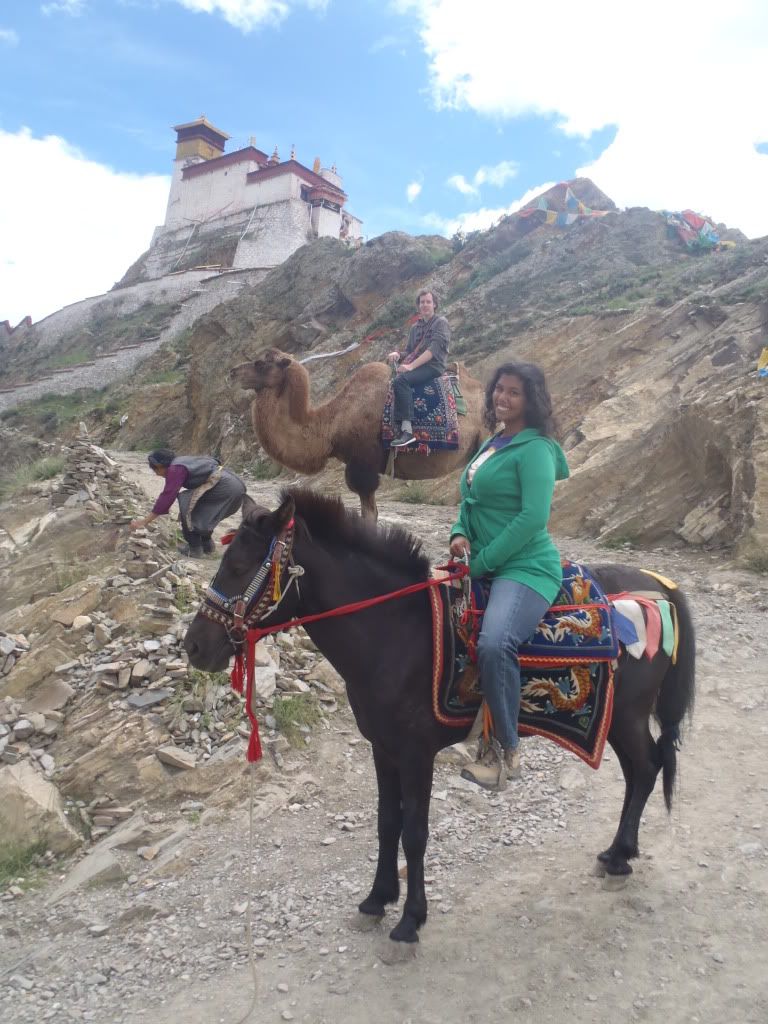
A little while later we arrived at the end of the path and the girls dismounted. I was sad to leave the camel, but made a great exit by not using a ladder, sliding off the camel instead. A few stairs later we entered the Yungbulakang Palace. Yungbulakang was Tibet’s first palace and one of the earliest buildings in Tibet, supposedly built in 127 BC. Its name means “Palace of Mother and Son” in Tibetan. Later, Yungbulakang became the summer palace of the 33rd king Songtsen Gampo and Princess Wencheng. After Songtsen Gampo had transferred his seat to Lhasa, Yungbulakang became a shrine and under the reign of the 5th Dalai Lama, a monastery of the Gelugpa School. Sadly, the Yungbulakang was heavily damaged and reduced to a single storey during the Cultural Revolution, but it was reconstructed in 1983.


We had a look inside the smallish chapel and found a few statues, namely Thiesung Sangjie Buddha, King Niechi, the first King of Tibet, Songtsen Gampo and other Tubo kings. I have to admit that the statues start looking rather alike after seeing so many of the same faces so many times. Still, the beautiful location of the palace made this place memorable and unique. Not unique enough to take pictures inside though, for the tickets themselves were pricey enough already…
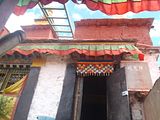
Instead we headed back down, this time by foot. Ray suggested we have lunch in Tsetang, the only city of any size in the hours to come. Besides, Francesca still wanted to see Traduk Temple, one of the earliest temples in Tibet. Sam and I were a bit templed out and decided to stay in the car whilst Francesca and Ray headed inside. A short while later they came back, and Francesca told me what she had seen and learned. Apparently, Traduk had been built in the 7th century by King Songtsen Gampo to subdue the demons that were on the loose. She said that the most impressive sight of the Traduk was the ‘Pearl Thangka,’ an image of King Songtsen Gampo's wife, Princess Wencheng. She’s represented as the White Tara, and the image is created from thousands of tiny pearls meticulously sewn onto a pink background. Here’s a picture I found online!
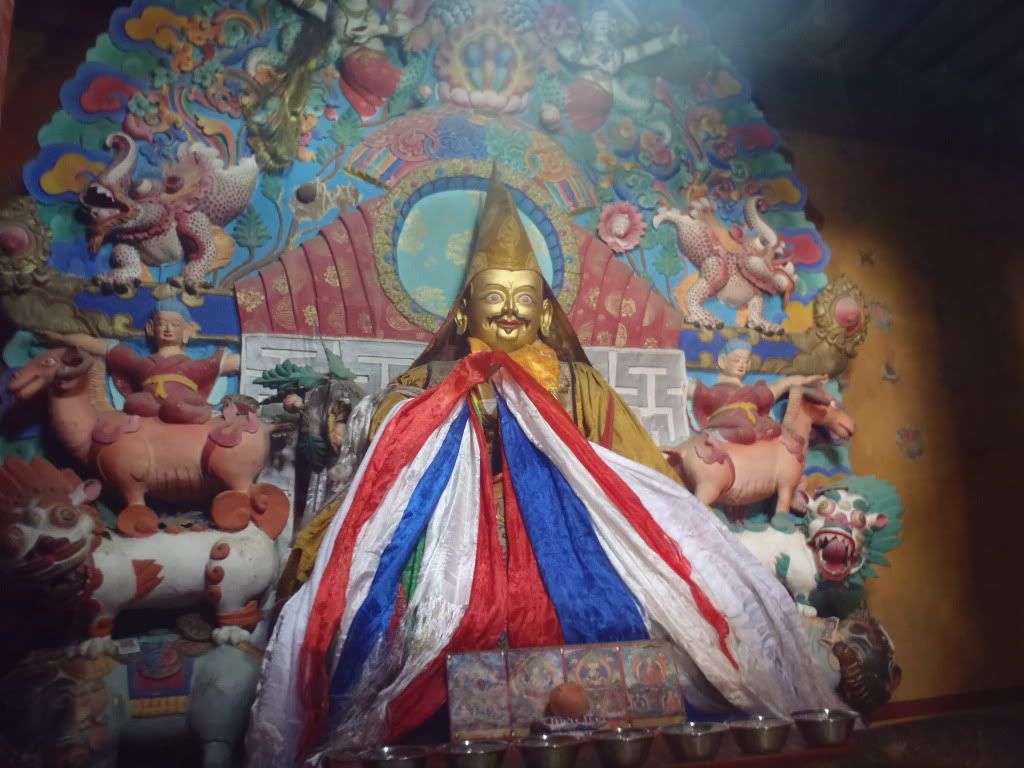

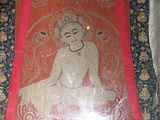
It was well past 2:00 PM when we finally arrived back in Tsetang for lunch. We made a beeline for Tashi Restaurant and somewhat enjoyed a decent yak thukpa and a mediocre cheese pizza. We left Tsetang behind us with the sun still shining brightly, but on our way to the next destination we could see dark clouds gathering in the valley ahead of us. We had all wanted to see Mindroling Monastery, one of the few Nyingma buildings on our itinerary. Monday turned off onto this dusty road as the first drops started to fall. Up in the distance we could barely see the valley anymore, as the rain seemed to have started in earnest.
We slowly made our way up the road, where sand and dirt had turned into mud. After about 15 minutes of driving the road stopped looking like a road altogether, instead having turned into a raging river of brown water. There was absolutely no chance of making our way through that mess, even with our car… We had no choice but to turn back and look for a place to sleep for the night. Sometimes Mother Nature just doesn’t want to play nice!
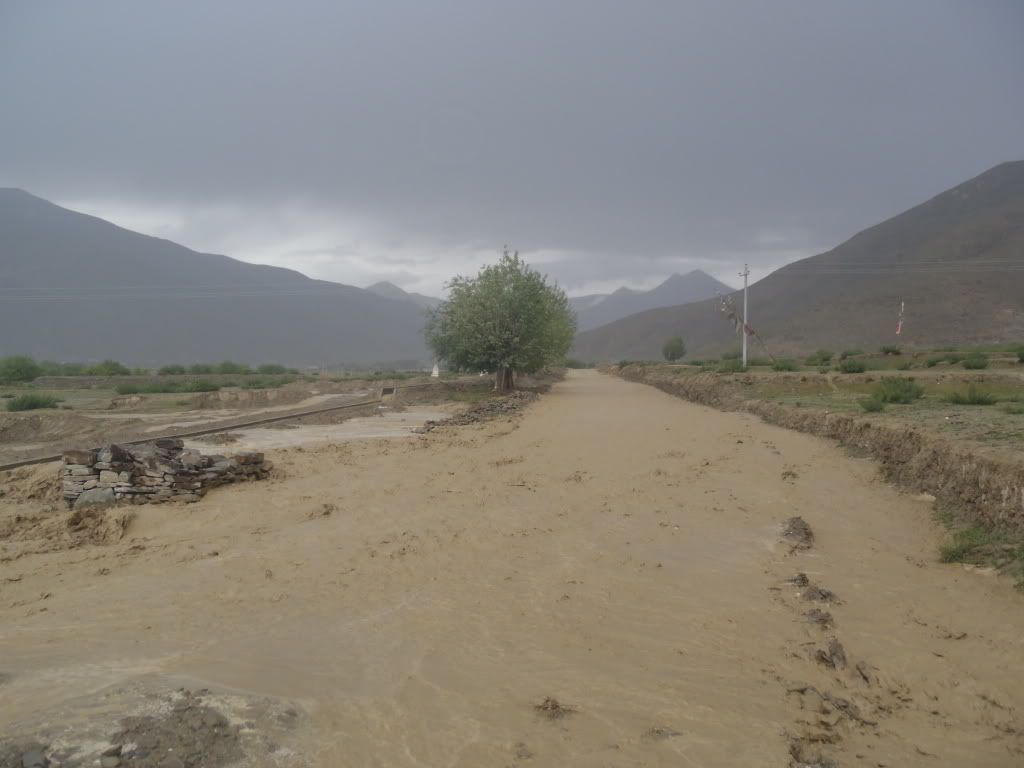
A few boring hours passed slowly, as everyone but me seemed to doze off into a slumber. Around 6:00 PM Monday started the ascend of the next pass on our way to new destinations. The Tsola Pass saw us reach an altitude of 4900 meters, with a great view of Yamdrok-tso Lake in the distance. I got Francesca out of the car for a few photos of us and the large body of water behind us. It would also be the last we’d get to see of the lake that day. On our way down to the small town of Nagartse the sun quickly disappeared and darkness surrounded us. Ray found us another nameless hotel, this time without running water, but with a decent bed and lots of blankets to keep us warm. We dropped off our bags and went for dinner in an unnamed restaurant. We sat down in what looked like a living room and had a look at the menus. Francesca and Sam both got chicken with cashew nuts, whilst I had another thukpa. I have to admit the girls’ meal was a little better than mine that time. We ran back through the rain and found shelter in our rooms, where sleep soon gained the upper hand.
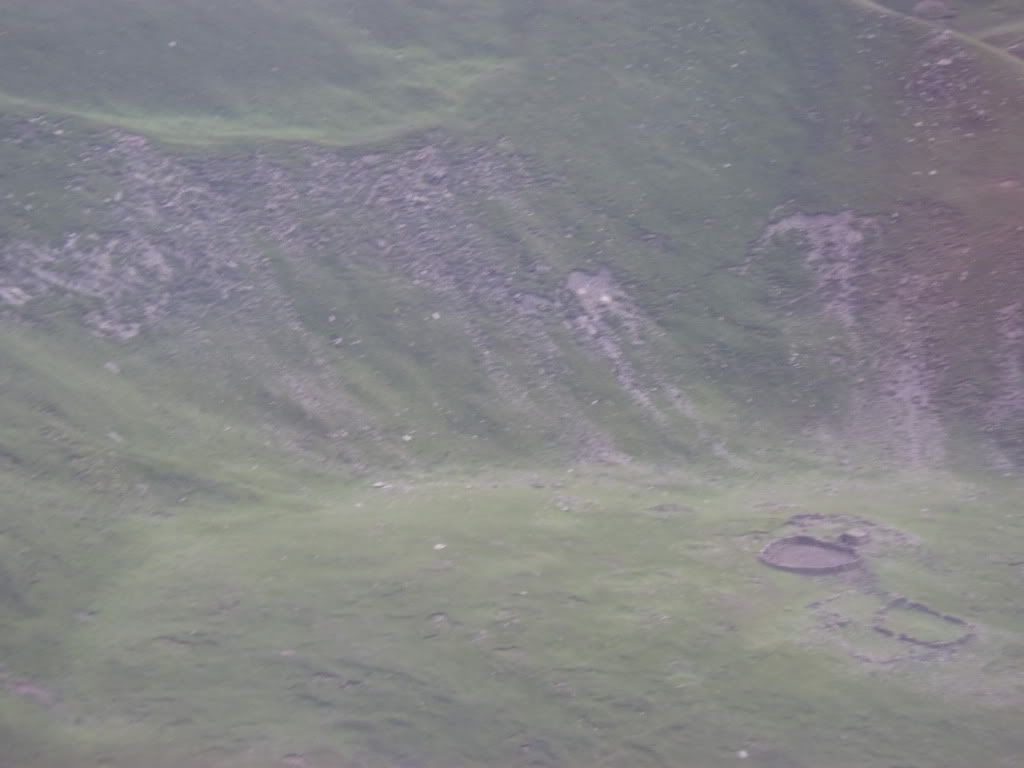


Our first stop of the day would be the third of the three great Gelugpa Monasteries: Ganden Monastery. The 45 kilometer drive from Lhasa took us east of the city, and up into the mountains. A scenic drive it was also, as proven by some of the following pictures. Ganden Monastery lies at the top of Wangbur Mountain at an impressive altitude of 4500 meters – that’s 900 meters higher than Lhasa! Seeing it appear in the distance, majestically situated on the saddle of the green hills ahead of us, was quite simply breathtaking.

Here are some facts and figures about the Monastery’s history from Wiki:
“[The full name of the Monastery is) is Ganden Namgyal Ling. Ganden means "joyful" and is the Tibetan name for Tusita, the heaven where the bodhisattva Maitreya is said to reside. Namgyal Ling means "victorious temple." It was the original monastery of the Geluk order, founded by Tsongkhapa himself in 1409, and traditionally considered to be the seat of Geluk administrative and political power. The Ganden Tripa or 'throne-holder of Ganden' is the head of the Gelukpa School. Being the farthest from Lhasa of the three university monasteries, Ganden traditionally had a smaller population with some 6,000 monks in the early 20th century.” Nowadays a mere 300 monks find their home in Ganden.

Cold as it was that high up, Francesca put on Sam’s sweater – that she definitely needed – and all of us headed for the Monastery proper. Ray purchased himself some juniper and chucked it in the enormous incense burner in front of one of the halls. We learned that burning juniper and incense – sometimes with some tsampa added in – is believed to produce purifying smoke. It is used in both monasteries and homes to make people's body and soul purified. Besides the nice smell the burning juniper produced the heat emitted by the burner was quite nice as well.


Onwards and upwards! We headed up the stairs to check out the first of the three main sights in the Ganden Monastery. The Ngam Cho Khang Chapel, the place where Tsongkhapa himself traditionally taught his lessons, was our first stop. Books filled with Buddha’s texts lined the wall of the enormous hall. We learned from Ray that you’re supposed to walk under the books to acquire a little knowledge and gain some merit. Naturally we followed suit and emerged a tad bit more enlightened. It was no surprise to hear that the hall was still in use, even though the resident monks cannot fill all the seats inside even if they were to bring their entire families. Statues can be found at the back-end of the hall, where Tsongkhapa is accompanied by two of his disciples. The future Buddha Maitreya also makes his mandatory appearance.



A short walk past some more colorfully painted buildings and walls led us to the Tsokchen Assembly Hall, where we discovered the triple longevity Buddhas, as well as another sand mandala. I still can’t get over the beauty of those things! A little more interesting were the ritual cakes made out of yak butter and tsampa. These guys can literally make anything with yaks and barley… We paid to take some pictures in a special hall with a Shakyamuni Buddha, encased in glass with a beautifully carved wooden frame. On either side of the statue were more glass encasings with rows and rows of smaller Shakyamunis. The small stupa (also behind glass) is sad to have been left untouched since Buddha’s life. I’m not entirely sure about that, what with all the destruction and reconstruction going on in the past…


Next to that hall Ray pointed out the bull-headed protector’s chapel. Apparently, only men are allowed to view Yamataka’s statue here. I left the girls in Ray’s care and had a quick look in the small chapel, where several monks were chanting away. Not terribly impressed by it I headed back out to join our little sortie as we made our way to our third hall.



The definite highlight however came in the shape of the Serdung, or Holy Stupa Hall. The Serdung was used by Tsongkhapa and other Tripas. In 1419, Tsongkhapa passed away and in the following year his disciples established the hall for him, as well as a silver pagoda inside with more than 35 kilograms of silver to surround the master's body. Afterwards, the thirteenth Dalai Lama covered it with pure gold. From then on, each time a Tripa died, a silver pagoda would be built in their honor. In the time leading up to the Chinese invasion of Tibet, 95 pagodas were built.

Sadly, the tomb was partially destroyed during the Cultural Revolution and I can only imagine that the rebuilt tomb of Tsongkhapa looks a little less impressive than its predecessor. Ray led us back to the car and told us we’d have lunch back in Lhasa. We were a little surprised to learn we’d be going back to Lhasa so soon, but it made sense with the direction we’d be going in and at least Lhasa would have a variety of food on offer.
Driving back through the gorgeous Lhasa River Valley was no punishment, and Lhasa and its Chinese construction came back in view all too quick. Before finding ourselves a place to eat Francesca and Sam tried to find the ‘great bakery’ she’d been told to go to. I had tried looking for it the night before, but hadn’t been able to locate it. Luckily Sam had a drawn map, which helped us find the courtyard of a hotel, where the “Summit Café” had been hidden. The snacks on display quickly got the girls’ attention! Francesca and I got a chocolate cake, a brownie and chocolate chip cookie for the road, as well as a whole stack of Coke Zero-cans, because they were extremely hard to get elsewhere.
Lunch followed and was to be ordered in the Tashi One, a place we hadn’t visited before. Boy, were we surprised to find the entire place empty! We took a table and perused the menu. It didn’t take long to make up our minds, as the house specialty was a chicken and vegetable wrap with a cream cheese sauce. We ordered a few portions of the wraps, along with some fried yak momos. The food came quickly and tasted pretty good. We have to admit that the wraps looked and tasted a little ‘Mexican.’ Perhaps there’s a future in Tibet-Mex after all! The fried yak momos were sadly not as good as their boiled counterparts – we made a mental note to stick to the latter from then on.


Inevitably lunch ended and driving continued. Saying goodbye to Lhasa for the second time that day, we drove out of the city in a … direction. On our way out we spotted a giant statue of two yaks by the side of the road. Pretty neat! After a good 2 hours of driving Monday and Ray thought it would be time for a break. We made a stop by the side of the road and climbed up to a small temple, where we had a great view of the river and mountains around us. We took some pictures and noticed how the landscape here looked distinctly different from our previous surroundings. There was far less green and far more sand, giving the area a distinct ‘desert’ look.



Ray even pointed our destination out, right across the river – just a small dot. A ferry would’ve easily been able to take us across in half an hour, but since it wasn’t in service at the time of writing we had to drive all the way around. The scenic drive was nice, but the little detour ended up costing us a few extra hours, seeing us arrive around 6:00 PM. We looked around for a hotel, quickly settling for a half-decent place near the Monastery. Since we’d bought so much, and had even brought part of that morning’s breakfast with us we decided not to go for dinner. I made us some sandwiches, which, combined with Francesca’s collection of chocolate goodies, made for a pretty decent dinner.


The next morning Francesca and I decided to do the same thing. There was no need to head out for a mediocre breakfast in the crappy town we were in. Instead we met Ray and Sam outside the hotel around 9:30 AM and headed straight for the only worthwhile sight in town: Samye Monastery. Wiki: “The Samye Monastery or Samye Gompa was the first Buddhist monastery built in Tibet, most probably constructed between 775 and 779 AD under the patronage of King Trisong Detsen. The King sought to revitalize Buddhism, which had declined since its introduction by King Songtsen Gampo in the 7th century.”

Furthermore, the Indian Buddhist masters Padmasambhava and Shantarakshita, whom the king had invited to Tibet to help spread Buddhism, play an important role in Samye’s history. Padamasambhava is credited with subduing the local spirits and winning them over to Buddhism. Padmasambhava's involvement makes Samye important in the Nyingma School, but it was later taken over by the Sakya and Gelugpa Schools. Today, Tibetans of all traditions come to worship here.
After purchasing our tickets we followed Ray inside and were immediately pleasantly surprised by the residing monks. They were setting up bowls of colorful sand around a flat table with an intricate drawing on it. If you’ve paid attention to previous posts you’ll know what the monks were about to begin: a sand mandala! We watched the monks put down the first ritual grains of colored sand and hoped we’d get to see plenty more. Ray, however, told us they’d continue setting up for a while longer and that we’d be better off exploring the main temple and its six floors first.

Here’s a little summary of the different sights from sacred-destinations.com: “Flanking the entrance to the main chapel are statues of historical figures associated with Samye's founding: Shantarakshita, Padmasambhava, Trisong Detsen and Songtsen Gampo are among those on the left. To the right of the assembly hall is the Gonkhang, a protector chapel, with eerie statues of former Bon demons that were turned into fierce Buddhist protector deities. The second floor is an open roof area, where monks and locals carry out the craft work for the temple. The third floor contains the Quarters of the Dalai Lama, with a small anteroom, throne room and bedroom. In the bedroom is a barred, glass-fronted case full of wonderful relics: Padmasambhava's hair and walking stick, a Tara statue that is reputed to speak, and the skull of Shantarakshita. The top floors have little to see in themselves, but provide excellent views from their balconies.”








After completing the exploration of the entire building in a speedy 30 minutes we all headed back down to the first floor to watch the monks work on their mandala. We earned a little more about the symbolism behind the image of the mandala in a museum in Nepal – here’s an explanation of how the image can be deconstructed: “The outermost edge of the mandala is a wheel of flames, which represents the basic elements of the world: earth, water, fire and wind. The following ring holds diamond-like lightning bolts (or ‘vajra’), which serve to protect the mandala from external enemies."



"The inner circle is much more interesting, as it is supposed to represent a tower built upon a giant lotus blossoming on the peak of Mt. Kailash. The roof of the tower is transparent, and sometimes several Buddha figures are drawn within, representing the five elements of body and mind: matter, sensation, simple concept, free will and consciousness. Thus, the mandala depicts both the universe and the individual, and in this way serves as a medium for the union of the cosmos and the self.” Impressive, right? And regardless of all the symbolism, these mandalas just look awesome! Watching the monks painstakingly placing grain after grain really left us all staring in amazement.


And you know what else is impressive? Samye Monastery itself is laid out on the shape of a giant mandala. The main temple in the center represents Mt. Kailash, the mythical mountain at the center of the Buddhist universe. The four continents in the ocean around Mt. Kailash are represented by four stupas at the cardinal points, each flanked by two smaller temples to symbolize islands in the ocean. We’d seen these four large stupas (or ‘chorten’ in Tibetan) from the 6th floor of the main chapel, and had wondered about their contents. We’d seen that they were all in different colors (red, white, black and green) and Ray told us the current chortens are rebuilt versions of older, destroyed creations and all look slightly different. They’re meant to represent the four king guardians, protecting the temple in the middle.
Ray took us to the black one, which had a few prayer wheels inside, as well as some staircases to higher levels. I was the only one interested in having a look (e.g. the only one that could be bothered to climb a few steps…) and found a few small niches with a few statues inside. Nothing special, safe for the view of the surroundings and Ray and the girls down below.


Just before noon we had a quick look at a smaller and older building. Ray showed us a ‘death’-door – a door with a small opening behind which death supposedly resides. Tibetans, since they believe in rebirth, aren’t particularly scared by death, so it was interesting for us to see their approach to something that still frightens a lot of Western people. Apparently, it’s also common practice to leave a note for a departed one on the door as the entire thing was covered in small pieces of paper with a few lines scribbled on.

After our encounter with ‘death’ we all headed back to the car and started driving again. We had another fairly long drive ahead of us to Nagartse and still had more things to see that day. Monday stepped on the pedal and skillfully drove our 4-wheel-drive to the Yungbulakang Palace, not too far from the grey Chinese hole we’d driven through the previous day, Tsedang. We saw the palace from quite a distance, perched on the edge of a mountain range in the distance. Arriving at the parking lot we realized we had quite a climb ahead of us in the hot weather. Francesca and Sam asked Ray for other options, whilst I decided I wouldn’t mind walking. When Ray told us there were horses available I still didn’t care much about 4-legged support. All of that changed the instant Ray pointed at a lone camel, also available for uphill transport!



Yes, I got to ride a camel up to the palace! I had no idea those things were so comfortable! We’ve sat on top of quite a few different animals now and I have to say in all honesty that a camel is most definitely the best mode of transport when it comes to the animal kingdom. The only downside is getting on the beast, as it required a ladder (even for me) to get seated. My camel and Francesca’s horse were taken by the hand and we were led uphill. The view of the environs were stunning, and adding a camel to an already picturesque situation can only lead to awesomeness.


A little while later we arrived at the end of the path and the girls dismounted. I was sad to leave the camel, but made a great exit by not using a ladder, sliding off the camel instead. A few stairs later we entered the Yungbulakang Palace. Yungbulakang was Tibet’s first palace and one of the earliest buildings in Tibet, supposedly built in 127 BC. Its name means “Palace of Mother and Son” in Tibetan. Later, Yungbulakang became the summer palace of the 33rd king Songtsen Gampo and Princess Wencheng. After Songtsen Gampo had transferred his seat to Lhasa, Yungbulakang became a shrine and under the reign of the 5th Dalai Lama, a monastery of the Gelugpa School. Sadly, the Yungbulakang was heavily damaged and reduced to a single storey during the Cultural Revolution, but it was reconstructed in 1983.


We had a look inside the smallish chapel and found a few statues, namely Thiesung Sangjie Buddha, King Niechi, the first King of Tibet, Songtsen Gampo and other Tubo kings. I have to admit that the statues start looking rather alike after seeing so many of the same faces so many times. Still, the beautiful location of the palace made this place memorable and unique. Not unique enough to take pictures inside though, for the tickets themselves were pricey enough already…

Instead we headed back down, this time by foot. Ray suggested we have lunch in Tsetang, the only city of any size in the hours to come. Besides, Francesca still wanted to see Traduk Temple, one of the earliest temples in Tibet. Sam and I were a bit templed out and decided to stay in the car whilst Francesca and Ray headed inside. A short while later they came back, and Francesca told me what she had seen and learned. Apparently, Traduk had been built in the 7th century by King Songtsen Gampo to subdue the demons that were on the loose. She said that the most impressive sight of the Traduk was the ‘Pearl Thangka,’ an image of King Songtsen Gampo's wife, Princess Wencheng. She’s represented as the White Tara, and the image is created from thousands of tiny pearls meticulously sewn onto a pink background. Here’s a picture I found online!



It was well past 2:00 PM when we finally arrived back in Tsetang for lunch. We made a beeline for Tashi Restaurant and somewhat enjoyed a decent yak thukpa and a mediocre cheese pizza. We left Tsetang behind us with the sun still shining brightly, but on our way to the next destination we could see dark clouds gathering in the valley ahead of us. We had all wanted to see Mindroling Monastery, one of the few Nyingma buildings on our itinerary. Monday turned off onto this dusty road as the first drops started to fall. Up in the distance we could barely see the valley anymore, as the rain seemed to have started in earnest.
We slowly made our way up the road, where sand and dirt had turned into mud. After about 15 minutes of driving the road stopped looking like a road altogether, instead having turned into a raging river of brown water. There was absolutely no chance of making our way through that mess, even with our car… We had no choice but to turn back and look for a place to sleep for the night. Sometimes Mother Nature just doesn’t want to play nice!

A few boring hours passed slowly, as everyone but me seemed to doze off into a slumber. Around 6:00 PM Monday started the ascend of the next pass on our way to new destinations. The Tsola Pass saw us reach an altitude of 4900 meters, with a great view of Yamdrok-tso Lake in the distance. I got Francesca out of the car for a few photos of us and the large body of water behind us. It would also be the last we’d get to see of the lake that day. On our way down to the small town of Nagartse the sun quickly disappeared and darkness surrounded us. Ray found us another nameless hotel, this time without running water, but with a decent bed and lots of blankets to keep us warm. We dropped off our bags and went for dinner in an unnamed restaurant. We sat down in what looked like a living room and had a look at the menus. Francesca and Sam both got chicken with cashew nuts, whilst I had another thukpa. I have to admit the girls’ meal was a little better than mine that time. We ran back through the rain and found shelter in our rooms, where sleep soon gained the upper hand.




0 Comments:
Post a Comment
<< Home